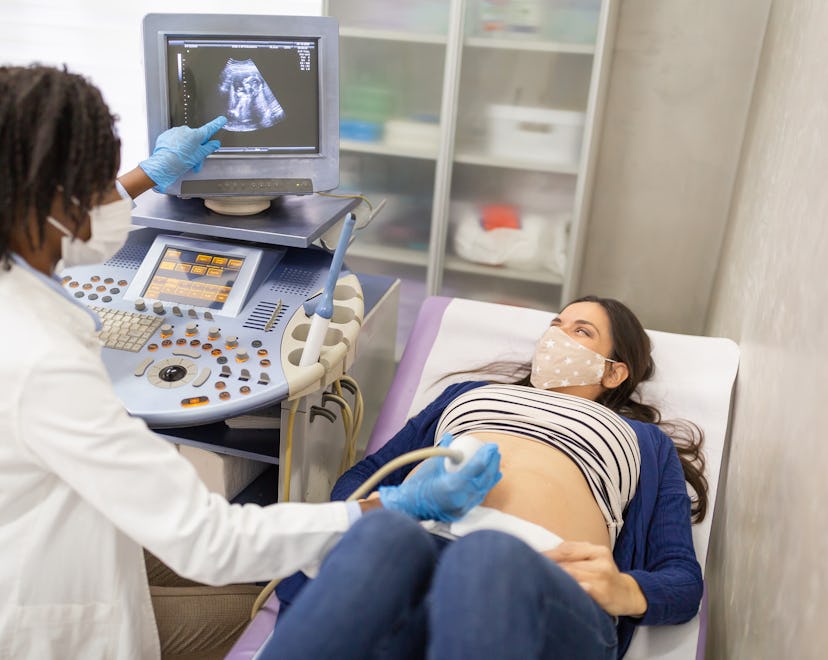Pregnancy

Does Anterior Placenta Mean C-Section?
Learn how the placenta’s location can impact your birth plan.
When you’re pregnant, your placenta is your baby’s lifeline. This vital organ develops inside of the uterus and is attached to baby’s umbilical cord until after birth. The placenta is so important, in fact, that the direction of your entire birth plan can hinge on its location. If you have an anterior placenta and your heart is set on a specific delivery method, you may be curious if an anterior placenta means a C-section is now part of your baby’s birth.
How do I know if I have anterior placenta?
Placenta location during pregnancy is determined during an ultrasound. Though this usually occurs at a 20-week ultrasound appointment (also known as an anatomy scan), Dr. Renita White, a board-certified OB-GYN at Georgia Obstetrics and Gynecology, tells Romper that placenta location can typically be seen on an ultrasound around 12 to 14 weeks gestation. So if you have an anterior placenta, your healthcare provider will usually let you know during a regularly scheduled ultrasound.
“Your OB provider will review placental location and implications for pregnancy,” Dr. Daniel Roshan, a board-certified OB-GYN with Rosh Maternal & Fetal Medicine, tells Romper. “Anterior placenta is considered normal and does not significantly increase your risk for pregnancy related complications for mom or baby.”
What are the different possible positions of the placenta?
Since the position of your placenta can impact your birth plan, it’s important to know where it’s located. “At the very beginning of pregnancy, the developing embryo attaches to the uterine wall and the location of the placenta is pre-determined by this,” White tells Romper.
Placenta location is typically given one of the following classifications:
- Anterior placenta: Attached to the front of the uterus.
- Posterior placenta: Attached to the back of the uterus.
- Fundal placenta: Attached to the top of the uterus.
- Lateral placenta: Attached to the side of the uterus.
- Placenta previa: Attached abdominally over the cervix.
But what does the location of your placenta mean for your delivery? “The location of the placenta only affects delivery in the case of a placenta previa,” White says. “In this situation, a C-section is necessary because the placenta is blocking the ability of the baby to come out.”
Does anterior placenta mean C-section?
When an anterior placenta is diagnosed, it does not automatically equate to a C-section. However, expectant parents with this placental location may still need a C-section depending on their personal history and other C-section risk factors. For this reason, Dr. Crystal Berry-Roberts, a board-certified OB-GYN at Austin Regional Clinic, strongly emphasizes the need for prenatal exams during the first trimester of pregnancy.
“A patient with an anterior placenta — when all other concerning factors that she could be at an increased risk for have been ruled out to the best of our ability with imaging — can have a successful vaginal delivery,” Berry-Roberts says.
One factor to consider with anterior placenta is whether or not you’ve had a previous C-section. “If mom has had a prior C-section, there is a chance the placenta can attach to the prior C-section scar, so she might need a little extra follow-up,” Dr. Kathleen Green, an OB-GYN provider with Maven Clinic, tells Romper. But still, this doesn’t automatically mean that you need a C-section. If you are considering a vaginal birth after cesarean (VBAC), it’s always best to discuss your options with your healthcare provider.
If you do need a C-section (or choose to have one), knowing the location of your placenta can be important in keeping you and baby safe during delivery. “Should you end up in a C-section, your doctor takes into consideration that your placenta is anterior and therefore, the focus is to try to not disrupt the placenta first before getting the baby successfully delivered,” Berry-Roberts tells Romper.
Can anterior placenta cause other complications?
“There are no studies that show a direct link between anterior placenta and complications of pregnancy,” according to Roshan. But, with anterior placenta, you may not feel baby’s kicks as early or as strong as with other placental positions. “This is because the placenta acts as a ‘pillow’ that absorbs the fetal movements and the mom does not feel them as strongly,” Roshan explains.
Though the direct correlation between anterior placenta and pregnancy complications isn’t outlined in studies, every pregnancy is different. Berry-Roberts tells Romper that when anterior placenta is combined with other maternal risk factors, there is can be a slightly increased risk for vaginal bleeding during pregnancy and hemorrhage at delivery — specifically for C-sections — though these complications are rare. For baby, these potential delivery complications could lead to neonatal anemia, preterm birth, or NICU admission at birth. However, this is also rare and a variety of other factors would likely come into play.
As always, it is best to discuss any concerns about your anterior placenta, or any other issues that may arise during pregnancy, with your healthcare provider.
Experts:
Crystal Berry-Roberts, M.D., MBA, FACOG, board-certified OB-GYN at Austin Regional Clinic
Renita White, M.D., FACOG, board-certified OB-GYN at Georgia Obstetrics and Gynecology
Kathleen Green, M.D., OB-GYN at the University of Florida and OB-GYN provider with Maven Clinic
Daniel Roshan, M.D., FACOG, FACS, a board-certified OB-GYN with Rosh Maternal & Fetal Medicine